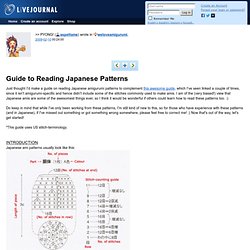

Standards & Guidelines For Crochet & Knitting. The publishers, fiber, needle and hook manufacturers and yarn members of the Craft Yarn Council have worked together to set up a series of guidelines and symbols to bring uniformity to yarn, needle and hook labeling and to patterns, whether they appear in books, magazines, leaflets or on yarn labels.

Our goal is to make it easier for industry manufacturers, publishers and designers to prepare consumer-friendly products and for consumers to select the right materials for a project and complete it successfully. Included are: We urge manufacturers, publishers and designers, to adopt these guidelines. Downloads of the graphic symbols are available at this web site at no charge. We ask that if you use them in any publication that you advise us in an e-mail of your intention to use them and that the following credit line be given: Source: Craft Yarn Council's www.YarnStandards.com. Amigurumi: Guide To Reading Japanese Patterns. Just thought I'd make a guide on reading Japanese amigurumi patterns to complement this awesome guide, which I've seen linked a couple of times, since it isn't amigurumi-specific and hence didn't include some of the stitches commonly used to make amis.

I am of the (very biased!) View that Japanese amis are some of the awesomest things ever, so I think it would be wonderful if others could learn how to read these patterns too. :) Do keep in mind that while I've only been working from these patterns, I'm still kind of new to this, so for those who have experience with these patterns (and in Japanese), if I've missed out something or got something wrong somewhere, please feel free to correct me!
:) Now that's out of the way, let's get started! *This guide uses US stitch-terminology. INTRODUCTIONJapanese ami patterns usually look like this: You may also see a stitch-counting guide at the side of the pattern, which shows how many stitches you should have in each row. How Do You Read A Crochet Pattern? There are currently no images from other crafters. close Terms & Conditions You must enter into this Agreement if you want to submit digital images or other content to Prime Publishing through Sharing Customer Images (the "Service").

As used in this Agreement, "we" or "Prime Publishing" means Prime Publishing, LLC. and "you" means the individual or entity submitting materials to Prime Publishing. Any individual or entity that wants to use the Service must accept the terms of this Agreement without change. 1) Eligibility. 2) Definitions. 3) License Grant for Materials. 4) Removal of Materials. 5) License for Name, Trademarks and Likenesses. 6) Specifications and Guidelines. 7) Representations, Warranties and Indemnities. 8) Restrictions. 9) No Obligation. 10) Changes to Agreement. 11) Prime Publishing Intellectual Property. 12) Communications. 13) Waiver. Crochet Abbreviations. Crochet Symbols & Terminologies. Crochet School 21: Reading Crochet Charts. Remember in the last lesson where I said that the simpler the pattern the better?

Well how's this for simple? (hover your mouse over to see the difference between the square and the chart overlay) Do you see how you could possibly not even need words to make a pattern if you knew what the symbols were? That's something that makes crochet awesome! Crochet has a system of symbols that is internationally known and accepted called the international crochet symbol system. Note: we have talked about US vs UK terms so far. I've found that some patterns will give written out directions along with a chart, which makes it a bit easier if you aren't sure what a symbol means. This first chart is of the general stitches that we have learned. The arrows on this image point to the parts of the stitch that make up the symbol. I for one love to read charts because I'm a visual person and the more information I can get packed into a visual is better.
Figure 1: Figure 2: Figure 3: